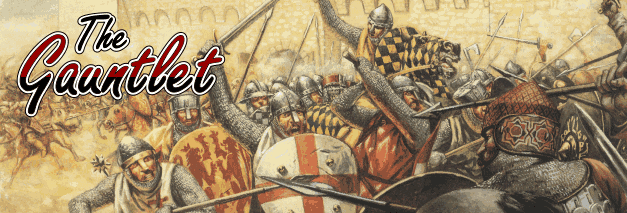
|

|
|
Archives of our Gauntlet Newsletter August 2017 - written by Mike Hamilton. Presented as text only for now. (Slightly edited by Rick Macmurchie) THE ACORN: Denotes antiquity and strength, Acorns hold high significance as a Scandinavian and a Celtic symbol for life, fertility, immortality and perseverance. It is said the Norse legend that Thor sought shelter from a thunderstorm under an oak tree has contributed to the belief that having an acorn on a windowsill will prevent a house from being struck by lightning. A theme in Roman architecture and equally popular in Celtic and Scandinavian art the acorn is used as an ornament on jewelery, furniture, and appears on finials in many countries. Chaucer wrote of "achornes of okes" in the 1300s. Etymology connected the word both with "corn" and "oak-horn," and the spelling changed accordingly. THE MUSKETEER: A musketeer (French: mousquetaire) was an early modem type of soldier equipped with a musket. Musketeers were an important part of early modern armies, particularly in Europe. In most cases they served on foot as infantry. though sometimes they could operate on horseback: as a cavalryman or dragoon. The musketeer was a precursor to the rifleman. Muskets were replaced by rifles in most western armies during the mid-1850s. The traditional designation of "musketeer" for an infantry private survived in the Imperial German Army until World War I THE HARROW (Herse): used in husbandry (agriculture, farming), A farm implement consisting of a heavy frame with sharp teeth or upright disks used to break up and even-off ploughed ground; HEAD: (Saxons, Saracenss Turks. Moors, Blackamoors, Savages, Maidens, Infants etc.) A human head stands for honour, there are many variations; a Saracen's head represents a Bedouin tribe from Sinai, the term was more generally applied to Arabs and Muslims during the Crusades and may denote one who fought in the Crusades against this tribe. A Saxon on the other hand was a member of a West Germanic tribal group that inhabited northern Germany and invaded Britain in the fifth and sixth centuries A.D. with the Angles and Jutes, and the head may symbolize some great battle against them. In the Middle Ages, the Europeans called all Mahometans (Muslims) Moors, in the same manner as the eastern nations called all inhabitants of Europe Franks. THE HEDGEHOG:It collects its stores for the winter with its prickles and is symbolic of a provident provider. In ancient Egypt, hedgehog amulets were worn to ward off snakebite. If approached by a snakes a hedgehog will bristle and roll up, fending off the reptile's striking fangs with its longer spines. When the snake is fatigued or wounded, the hedgehog attacks, biting along the backbone toward the head until the snake is dead. So it is said... |
|
|
--
|
|
|
Copyright © 2001-2025 - Armorial Gold Heraldry Services. |